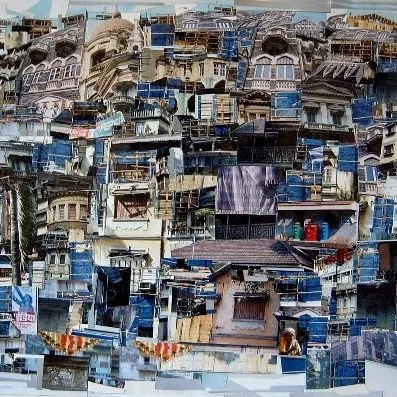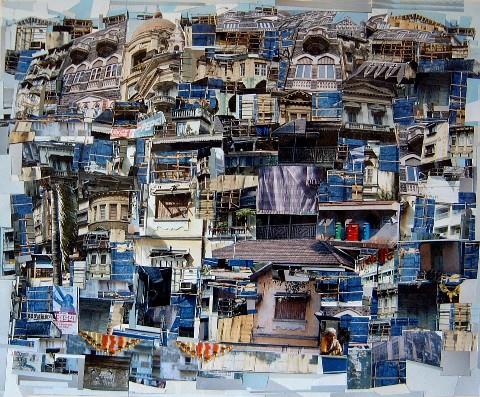The Million-Petaled Flower of Being Here | Rashmi Talpade
The Million-Petaled Flower of Being Here | Rashmi Talpade
Rashmi Talpade in her Wallingford studio. Photo: J. Gleisner.
On a wooden table in Rashmi Talpade’s kitchen, a small pair of scissors rest atop scraps of color photographs—a part of a metal chain, a series of stoplights, different views of barbed-wire fences. She works slowly, first cutting out the precise piece of one of her photographs and then affixing it to the appropriate place. Even in their unfinished states, two of Talpade’s smaller collages appear ornate. Her fastidious layering of pasted imagery creates tactile surfaces that underscore her crowded compositions.
These collages, with their vibrancy and intricacies, recall the energy and warmth of her hometown, Mumbai, India. In 1991, Talpade, then in her late twenties, arrived in Connecticut on a freezing February day wearing cropped pants and a light cotton sweater. She had never owned a coat or been the United States before. Her husband had been promoted to the Vice President of Finance at an overseas branch of his company, so together they moved to Wallingford, a quiet suburb north of New Haven.
Rashmi Talpade, Textures of Bombay (2004). Photo-collage, 20 by 24 inches.
“You discover so many pieces of yourself when you are transplanted to another place,” Talpade said. Aside from the weather, one of the biggest challenges for Talpade was adjusting to a small town. She had to get used to driving five miles to buy milk at the store, instead of having it delivered to her doorstep each morning. She learned to purchase groceries in bulk, planning for a week of meals, rather than picking fresh produce from the daily fruit vendor. For the first month, she was housebound, studying to take the test to receive a driver’s license. There were few places of interest within walking distance of her apartment in Wallingford and fewer pedestrians.
Moving meant a complete reboot for her career as an artist, too. Back in India, Talpade studied art at Sir J.J. School of Fine Art, a reputable school where she double-majored in ceramics and painting. (Becoming an artist was an unconventional path for an Indian woman in the late 1970s, but her parents were supportive.) The start of her career had been promising: the Museum of Modern Art in Bhopal, India purchased one of her collages and she had received several commissions, including one from the Ministry of Energy Resources from the Government of India in New Delhi. She had several shows around town, though there were few galleries and only one major contemporary art museum in Mumbai.
Rashmi Talpade, Terracotta (2017). Photo-collage; 20 by 16 inches.
In Connecticut, Talpade had no connections in the art world, but participating in City-Wide Open Studios helped her build relationships with curators and other artists. Around six years ago, she met Michael Shortell, who included her work in an exhibition at Five Points Gallery in Torrington. Last year, she exhibited again at this space in the group show, Paper Rock Scissors. Since the early 90s, Talpade has been a part of nearly every City-Wide Open Studios, learning how to talk about her work with new people. Each year has been fruitful: she’s sold pieces, been offered commissions, and met people who have supported her in other ways. Over the past twenty years, Talpade has exhibited extensively across the state and elsewhere.
At 57, Talpade shared that there have been less productive periods, but she developed a strategy to sustain her career as an artist. “If I’m not working with my hands, my mind is still working,” said Talpade. After her daughter was born, she did not have as much free time to devote to her practice, but she continued to work by fabricating plans for her future projects. “Now when I sit down to do the work, I pull out files from the mental library that I’ve created for myself,” she explained.
Rashmi Talpade, from her Modern Archaeology series. Image courtesy of the artist.
A series called Modern Archaeology resulted from one of these mental plans. Talpade began working on this body of work about two years ago, but she’s had the idea for nearly a decade. “Future generations are going to find a lot of our trash,” stated Talpade. Based on this premise, Talpade has been concocting small vignettes of specific objects such as a manhole cover she spotted on Canal Street that had been fabricated in India. Working with collage, her preferred medium, Talpade combines slices of her color photographs onto square panels, which are often displayed in large groupings. Cumulatively, they symbolize the chaos and waste of our current culture.
Looking back on her career, Talpade reflected, “I’ve been very fortunate to do exactly what I love.” Moving to Connecticut was a challenge and there have been other difficulties along her path as an artist, but Talpade’s positive spirit has helped her endure.
All of Talpade’s quotes are from a conversation with the author at Talpade’s home in Wallingford, Connecticut on August 5, 2019. Read more about this commissioned project here.







